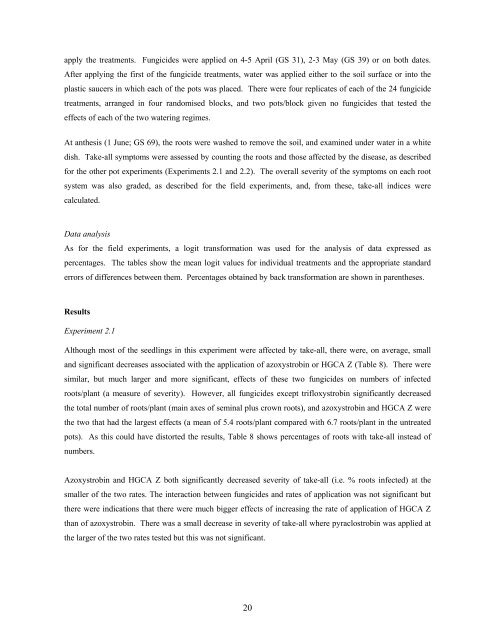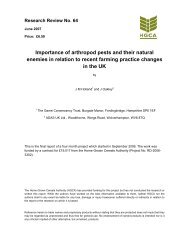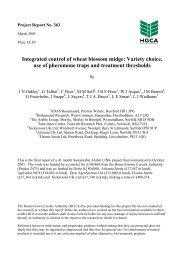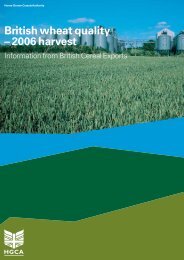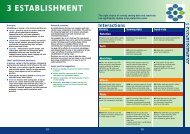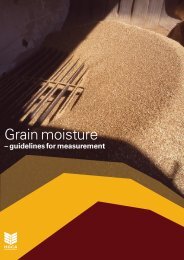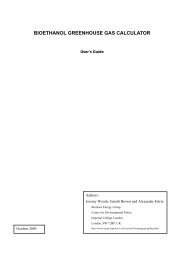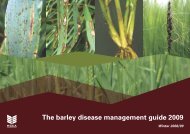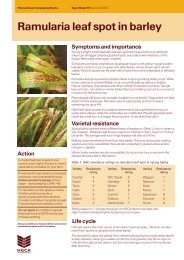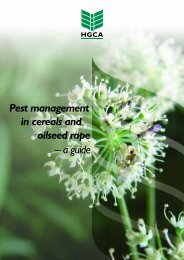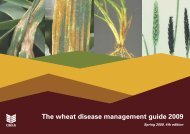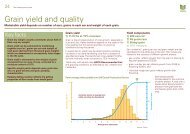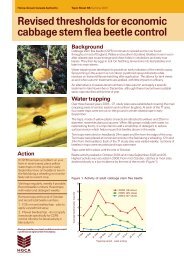PROJECT REPORT No. 285 EFFECTS OF ... - HGCA
PROJECT REPORT No. 285 EFFECTS OF ... - HGCA
PROJECT REPORT No. 285 EFFECTS OF ... - HGCA
- No tags were found...
You also want an ePaper? Increase the reach of your titles
YUMPU automatically turns print PDFs into web optimized ePapers that Google loves.
apply the treatments. Fungicides were applied on 4-5 April (GS 31), 2-3 May (GS 39) or on both dates.After applying the first of the fungicide treatments, water was applied either to the soil surface or into theplastic saucers in which each of the pots was placed. There were four replicates of each of the 24 fungicidetreatments, arranged in four randomised blocks, and two pots/block given no fungicides that tested theeffects of each of the two watering regimes.At anthesis (1 June; GS 69), the roots were washed to remove the soil, and examined under water in a whitedish. Take-all symptoms were assessed by counting the roots and those affected by the disease, as describedfor the other pot experiments (Experiments 2.1 and 2.2). The overall severity of the symptoms on each rootsystem was also graded, as described for the field experiments, and, from these, take-all indices werecalculated.Data analysisAs for the field experiments, a logit transformation was used for the analysis of data expressed aspercentages. The tables show the mean logit values for individual treatments and the appropriate standarderrors of differences between them. Percentages obtained by back transformation are shown in parentheses.ResultsExperiment 2.1Although most of the seedlings in this experiment were affected by take-all, there were, on average, smalland significant decreases associated with the application of azoxystrobin or <strong>HGCA</strong> Z (Table 8). There weresimilar, but much larger and more significant, effects of these two fungicides on numbers of infectedroots/plant (a measure of severity). However, all fungicides except trifloxystrobin significantly decreasedthe total number of roots/plant (main axes of seminal plus crown roots), and azoxystrobin and <strong>HGCA</strong> Z werethe two that had the largest effects (a mean of 5.4 roots/plant compared with 6.7 roots/plant in the untreatedpots). As this could have distorted the results, Table 8 shows percentages of roots with take-all instead ofnumbers.Azoxystrobin and <strong>HGCA</strong> Z both significantly decreased severity of take-all (i.e. % roots infected) at thesmaller of the two rates. The interaction between fungicides and rates of application was not significant butthere were indications that there were much bigger effects of increasing the rate of application of <strong>HGCA</strong> Zthan of azoxystrobin. There was a small decrease in severity of take-all where pyraclostrobin was applied atthe larger of the two rates tested but this was not significant.20


